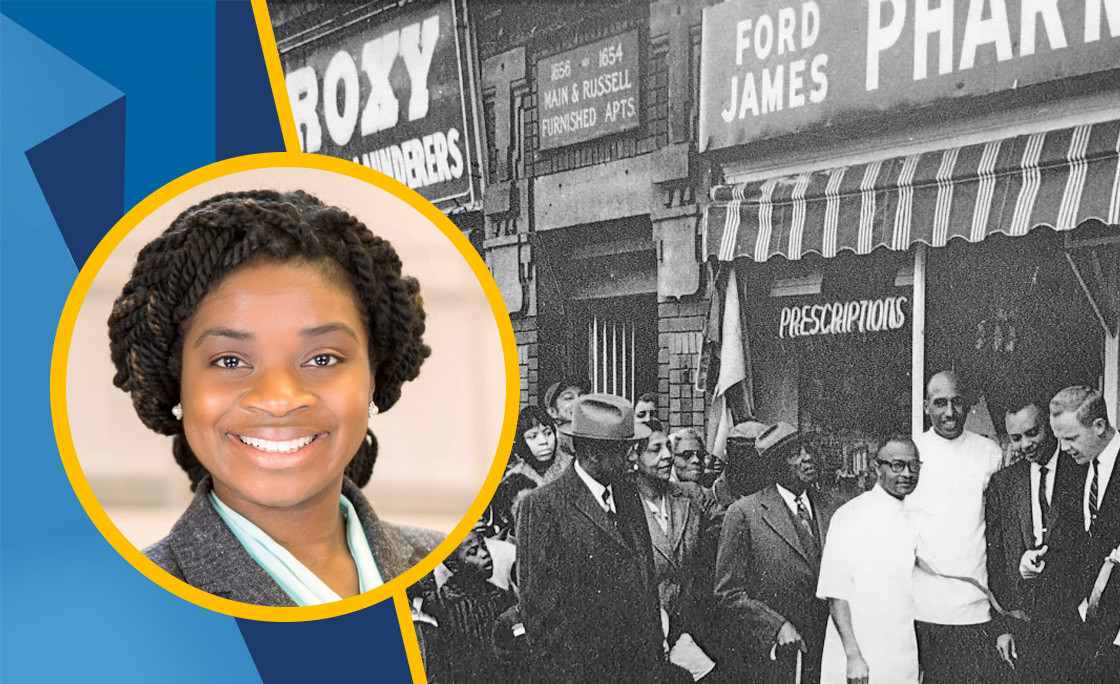

Introduction by Vice Chancellor Steve Goldstein and Vice Chancellor Douglas M. Haynes
The U.S. President proclaims February as National African American History Month each year. To commemorate and celebrate the contributions to our nation made by people of African descent, American historian Carter G. Woodson established Black History Week. First celebrated in 1926, that week was expanded into Black History Month in 1976 as part of the nation’s bicentennial.
As providers, we know that diseases like diabetes, heart attacks, stroke and cancer that can be managed and often reversed with good access to healthcare, are the leading causes of death and disability for African Americans. What is less well known is the history of African American pharmacists and how it relates to our current landscape of health inequity. Historically Black Colleges and Universities (HBCUs) emerged in the healthcare crisis that occurred after the Civil War, and they paved the path for the education of African Americans in pharmacy. Black-owned drugstores became a critical source of primary care for African Americans as they left slave plantations and well into the 20th century.
Then, in 1927, the American Medical Association (AMA) published its first list of hospitals approved for residency training, including in the field of pharmacy. While this was a step toward uniform quality standards, the guidance required financial resources that many HBCU schools lacked, leading them to close. Because Jim Crow laws of racial segregation were in full effect, predominately white schools denied or severely limited Black student enrollment. This combination of racism, segregation, and limited training options prevented many Black Americans from fulfilling their dreams of becoming pharmacists.
The impact on the health of African Americans was significant. Turn-of-the-century drugstores provided essential healthcare services, filling prescriptions, and offering guidance, that were unavailable to African Americans at many white-owned drugstores. The closing of HBCU pharmacy schools and resultant loss of black-owned drugstores curtailed access for African Americans, a deficit in public health services that is apparent in Black communities 100 years later, contributing to 21st century disparities.
Many African Americans challenged the discriminatory policies of drugstores by enacting lunch counter sit-ins to demand fair and just treatment – an essential piece of history that pharmacies played in the civil rights movement. In that spirit of determination, and reflecting the UCI Health Affairs imperative to reveal the basis for disparities and redress them, Cheryl Wisseh, PharmD, MPH, Health Sciences Assistant Clinical Professor, UCI School of Pharmacy & Pharmaceutical Sciences, offers today’s essay in the Bridging the Gap series where we focus on health equity.
Professor Wisseh conducts groundbreaking community-engaged research on health disparities and the social determinants of health, advancing the unique roles pharmacists play in primary care and as community liaisons. By serving as a community activist and developing a curriculum to address disparities in marginalized communities, her work is teaching current and future generations of pharmacists to provide culturally competent, quality health care – a feat we celebrate each of the 28 days in February and every day that follows.
Black History Month
By Cheryl Wisseh, PharmD, MPH
Health Sciences Assistant Clinical Professor, Department of Clinical Pharmacy Practice

February marks Black History Month, a time to celebrate the rich culture and incredible contributions of Black people throughout history. Black History Month also serves as an opportunity to address sustainable, community-driven solutions to improving healthy food access, equitable housing, recidivism, economic empowerment, and educational opportunities.
My life’s work as a clinical pharmacist centers around breaking down barriers through clinical practice, research, community solutions, and advocacy to dismantle structural racism and social factors that threaten and hurt people’s health– especially marginalized individuals. As a first-generation immigrant who identifies as African American, I know personally that cardiovascular disease is one of the leading causes of death for Black people nationwide, along with cancer and stroke. While significant advances have been made in treating and preventing chronic conditions, not all economic, racial, and ethnic groups benefit equally. Historically, communities of color have been left out.
As a blossoming health disparities researcher and community health advocate, I believe it is critical to the success of public health to help raise awareness about chronic conditions through health promotion and disease prevention to all communities. As a pharmacist, I have observed that many health disparities exist in geospatial manner: in rural areas, the lack of access of brick and mortar pharmacies are more prominent. In urban areas, the volume of patient needs likely results in less-than-ideal quality health care and services, considering lower ratios of pharmacies per 1,000 residents. Often in urban or impoverished communities, there is not enough green space to encourage outdoor activities, and too many lower-tier grocery stores serve as the sole source of foodstuff to these communities. It is no surprise that these issues keep festering the same cycle of health disparities. In the end, the resultant complications are the same for most chronic conditions that affect marginalized communities even if they live across different geographical locales.
With more pharmacists going into primary care, there is an urgent need to get the community involved. That is why in my day-to-day and research efforts, I am focused on the social determinants of health (SDOH) and their impact on underserved and minority communities. I also look at things from a unique angle of what the pharmacist’s role could be in addressing some of these disparities. The pharmacist can work within an interdisciplinary team to assess clinical data and develop meaningful programming for the community. The pharmacist also acts as a community liaison and trusted advisor to many patients and serves as a vital extension of the medical community to help at-risk individuals with comprehensive medication management.
Funding SDOH research is vital because social determinants shape the health experience. SDOH gets to the root cause that many marginalized communities struggle with. There can no longer be a band-aid approach to addressing health disparities – the way forward must include community-centered and culturally relevant solutions.
My involvement with the National Pharmaceutical Association (NPhA), a professional organization of pharmacists committed to serving the underserved, promoting minorities in pharmacy and championing racial and health equity, further strengthened much of my community advocacy work in and out of the classroom. I recently completed my two-year term on the NPhA Board of Directors as the Zone 5 Director. In this role, I developed a strategic plan on community engagement, advocacy, and growth and development for organization members in the West. I also worked alongside my fellow Board of Directors members, in strategic partnerships with other national pharmacy organizations. It was humbling and rewarding for me both from a professional and personal standpoint to be at the forefront of shaping public policy and advocacy work for the pharmacy profession.
Current and future pharmacists are eager to learn, do more, and be better informed of historical and generational trauma that has influenced marginalized communities. By having a seat at the table through NPhA, representing the views of many Black and minority pharmacists, I aim to address health disparities by teaching the next generation of clinical pharmacists to be culturally competent and humble practitioners. I realized how important it is to teach this in schools and colleges of pharmacy and am currently developing a module within a UCI PharmD program course that looks at these critical issues and how this impacts SDOH and one’s health.
The COVID-19 pandemic has put a positive spotlight on pharmacists’ unique role in addressing health disparities in communities across America. From vaccine deployment to COVID-19 testing, today’s pharmacists serve dual roles as health care providers and community liaisons on the frontlines. This Black History Month, we can pay a special homage to the Black Civil War-era pharmacists that started it all.